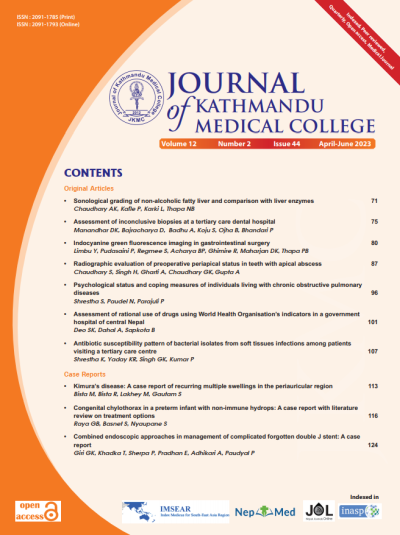Sonological grading of non-alcoholic fatty liver and comparison with liver enzymes
DOI:
https://doi.org/10.3126/jkmc.v12i2.53553Keywords:
Enzymes, Liver, Non-alcoholic fatty liver, Sonological gradingAbstract
Background: Non-alcoholic fatty liver disease (NAFLD) is becoming more well acknowledged as a significant contributor to liver-related morbidity and mortality.
Objectives: To assess the sonological grading of non-alcoholic fatty liver disease and comparison with liver enzymes.
Methods: An analytical cross-sectional study was conducted from 2022 August to 2023 January among the patients referred to radiology unit for liver sonography with diagnosis of non-alcoholic liver disease. Ethical approval was obtained from the institutional review committee of Kathmandu Medical College (Ref. 12082022/06). A convenience sampling method was used. The sample size calculated was 107. Descriptive statistics (frequencies, means, and standard deviations) was used to describe the variables of interest. One-way analysis of variance was applied for comparison of serum liver enzymes in between various grades of NAFLD at 5% significance level.
Results: Mean age of the patients was 37.9 ± 17.8 years, with 60% females. Most patients had grade I NAFLD (82, 76.6%), whereas 23 (21.5%) were of grade II. Levels of liver enzyme: Serum glutamic pyruvic transaminase (SGPT) with p-value 0.02 and serum glutamic oxaloacetic transaminase (SGOT) with p-value 0.03 were associated with fatty liver grade.
Conclusion: Ultrasound-based grading of the severity of NAFLD was associated with abnormalities in the liver enzyme profile of patients. The SGPT and SGOT levels correlated with increasing severity of NAFLD based on ultrasound.
Downloads
Downloads
Published
How to Cite
Issue
Section
License

This work is licensed under a Creative Commons Attribution-NonCommercial 4.0 International License.
Copyright © Journal of Kathmandu Medical College
The ideas and opinions expressed by authors or articles summarized, quoted, or published in full text in this journal represent only the opinions of the authors and do not necessarily reflect the official policy of Journal of Kathmandu Medical College or the institute with which the author(s) is/are affiliated, unless so specified.
Authors convey all copyright ownership, including any and all rights incidental thereto, exclusively to JKMC, in the event that such work is published by JKMC. JKMC shall own the work, including 1) copyright; 2) the right to grant permission to republish the article in whole or in part, with or without fee; 3) the right to produce preprints or reprints and translate into languages other than English for sale or free distribution; and 4) the right to republish the work in a collection of articles in any other mechanical or electronic format.




